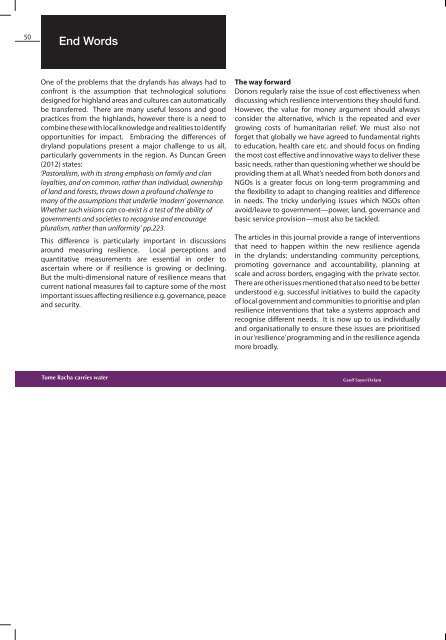Download PDF - ReliefWeb
Download PDF - ReliefWeb
Download PDF - ReliefWeb
- No tags were found...
Create successful ePaper yourself
Turn your PDF publications into a flip-book with our unique Google optimized e-Paper software.
50 51End WordsRegional Learning and Advocacy Programme for Vulnerable Dryland CommunitiesOne of the problems that the drylands has always had toconfront is the assumption that technological solutionsdesigned for highland areas and cultures can automaticallybe transferred. There are many useful lessons and goodpractices from the highlands, however there is a need tocombine these with local knowledge and realities to identifyopportunities for impact. Embracing the differences ofdryland populations present a major challenge to us all,particularly governments in the region. As Duncan Green(2012) states:‘Pastoralism, with its strong emphasis on family and clanloyalties, and on common, rather than individual, ownershipof land and forests, throws down a profound challenge tomany of the assumptions that underlie ‘modern’ governance.Whether such visions can co-exist is a test of the ability ofgovernments and societies to recognise and encouragepluralism, rather than uniformity’ pp.223.This difference is particularly important in discussionsaround measuring resilience. Local perceptions andquantitative measurements are essential in order toascertain where or if resilience is growing or declining.But the multi-dimensional nature of resilience means thatcurrent national measures fail to capture some of the mostimportant issues affecting resilience e.g. governance, peaceand security.Tume Racha carries waterThe way forwardDonors regularly raise the issue of cost effectiveness whendiscussing which resilience interventions they should fund.However, the value for money argument should alwaysconsider the alternative, which is the repeated and evergrowing costs of humanitarian relief. We must also notforget that globally we have agreed to fundamental rightsto education, health care etc. and should focus on findingthe most cost effective and innovative ways to deliver thesebasic needs, rather than questioning whether we should beproviding them at all. What’s needed from both donors andNGOs is a greater focus on long-term programming andthe flexibility to adapt to changing realities and differencein needs. The tricky underlying issues which NGOs oftenavoid/leave to government—power, land, governance andbasic service provision—must also be tackled.The articles in this journal provide a range of interventionsthat need to happen within the new resilience agendain the drylands: understanding community perceptions,promoting governance and accountability, planning atscale and across borders, engaging with the private sector.There are other issues mentioned that also need to be betterunderstood e.g. successful initiatives to build the capacityof local government and communities to prioritise and planresilience interventions that take a systems approach andrecognise different needs. It is now up to us individuallyand organisationally to ensure these issues are prioritisedin our ‘resilience’ programming and in the resilience agendamore broadly.Geoff Sayer/OxfamThe Regional Learning and Advocacy Programme (REGLAP) for Vulnerable Dryland Communities is a consortium thatpromotes lesson learning and good practice documentation on strengthening dryland resilience (in Ethiopia, Kenya andUganda) and advocates to governments, NGOs and other stakeholders for improved policy and practice.The REGLAP programme has been operating since June 2008 and is funded by ECHO. It is now its 4 th phase, which willoperate from Jan 2012 to June 2013.REGLAP 4 has the following structure:Regional Learning Groups on key issues for DRR in the drylands to develop good practice models and guidance andstrengthen the evidence base for dryland resilience promotion:1. Community based approaches to DRR (CARE, VSF-G, Cordaid, COOPI, ACTED, FAO): CMDRR, cross borderapproaches, conflict sensitive programming, PNRM.2. Water development for DRR (IUCN, Oxfam, FAO): developing and promoting good practice models forintegrated water planning.3. Strengthening the evidence base for DDR advocacy (Save, ILRI-TC, FAO, CARE, Mercy Corps): analysingavailable research, promoting/filling research gaps to get clearer and shared understanding of resilience inthe drylands, promote joint messaging.Country Advocacy Groups advocate on the key constraints to resilience building for the drylands to governments andother key actors.1. Kenya: (Cordaid, PDNK, RECONCILE, FAO, ISDR, Oxfam): ASAL Policy and structures, NDMA roll out andestablishment of contingency fund, communal land bill.2. Ethiopia (Oxfam, Save, CARE, Cordaid, FAO): woreda level integrated planning, land use, cross border coordination.3. Uganda (DCA, C&D, ACTED, COPASCO, Oxfam, FAO): DEWs, livestock disease surveillance, pastoral code/rangeland management policyThe REGLAP Secretariat provides overall co-ordination and supports the country and learning groups; publishes abiannual journal, good practice principles and technical briefs; and oversees targeted strategic studies to strengthen theevidence base for advocacy.The REGLAP consortium currently includes: CARE, Cordaid, Dan Church Aid, IUCN, Oxfam GB and Save the Children, andcollaborates with a range of local CSOs and networks, governments, research organisations and ECHO DRRAP partners.For further information please contact:Vanessa Tilstone, MLC Manager: vtilstone@oxfam.org.ukAchiba Gargule, Policy and Advocacy Advisor: agargule@oxfam.org.ukREGLAP Organogram
















